There is nothing quite like the sight of morning glories to greet you at the dawn of a new day. If you enjoy these flowering vines, you can bring their beauty to your own garden with the help of our morning glory growing guide.
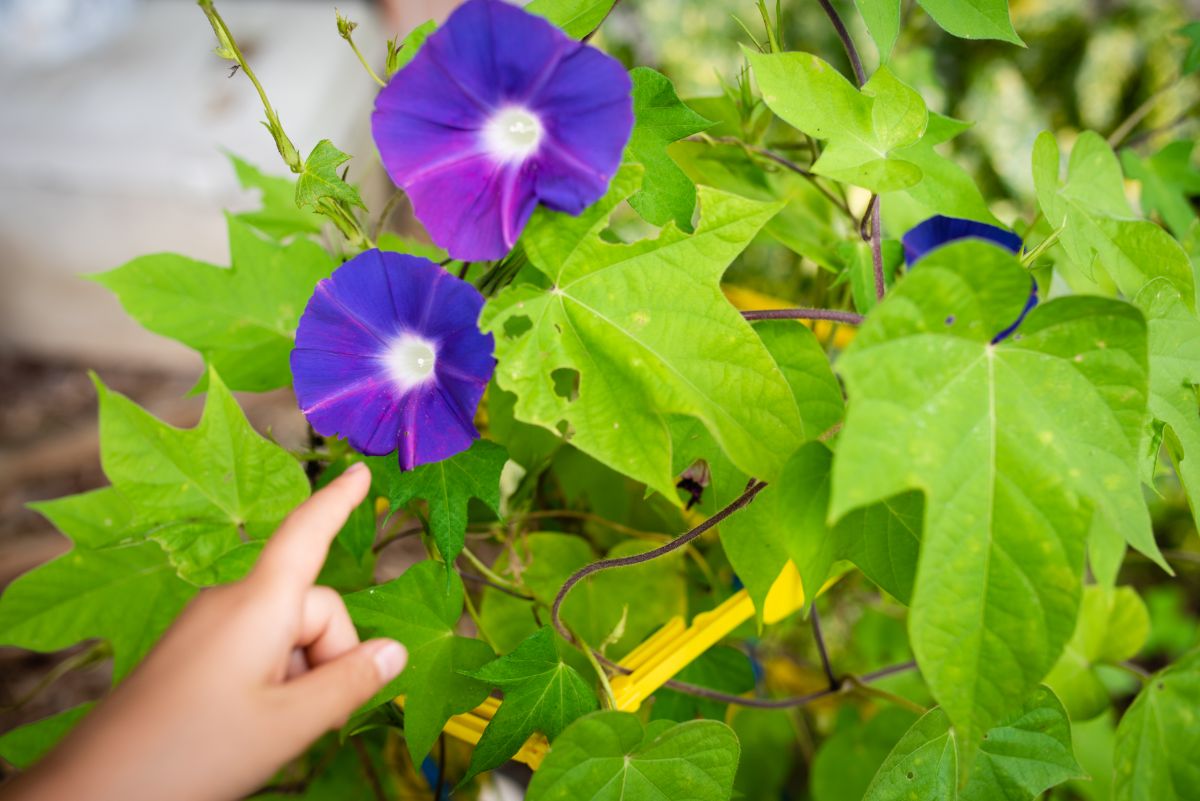
We will teach you how to plant and maintain these beautiful tender perennials, reviewing their ideal growing conditions and instructions for mulching, pruning, and more. Jump to any section in the advanced jump below.
Jump to:
- What Are Morning Glories?
- Do Morning Glories Change Color?
- Are Morning Glories Invasive?
- Morning Glory Basics
- Where Do Morning Glories Grow?
- Why Grow Morning Glories?
- Morning Glory Landscaping Ideas
- Recommended Morning Glory Varieties
- When Do Morning Glories Bloom?
- How Long Do Morning Glories Bloom?
- When to Plant Morning Glories
- Ideal Growing Conditions for Morning Glories
- How to Plant Morning Glories
- How to Propagate Morning Glories
- How to Care for Morning Glories
- Recommended Planting Combinations for Morning Glory
- Frequently Asked Questions About Morning Glories
- Where to Buy Morning Glories
What Are Morning Glories?
“Morning glory” refers to plants that are in the family Convolvulaceae, which is itself referred to as the “morning glory family” or sometimes the “bindweed family.” There are more than 1,000 species in the family.
There are quite a few genera included in this family. Some examples include Convolvulus, Argyreia, and Rivea.
These vines tend to flower in the morning each day, then fade. That is why we call them “morning glories.” There are some exceptions, however. Some types of morning glories even bloom at night, making them suitable for moonlight gardens.
A lot of people believe that morning glories are annuals, but they are actually classified as tender perennials.
This status simply means that if you are living in zones 9-11, you can grow morning glories as perennials and enjoy them each year.
But if you are living in a colder climate, then your morning glories are unlikely to survive the winter (that said, there are some types of morning glories that are somewhat cold-hardy).
Do Morning Glories Change Color?
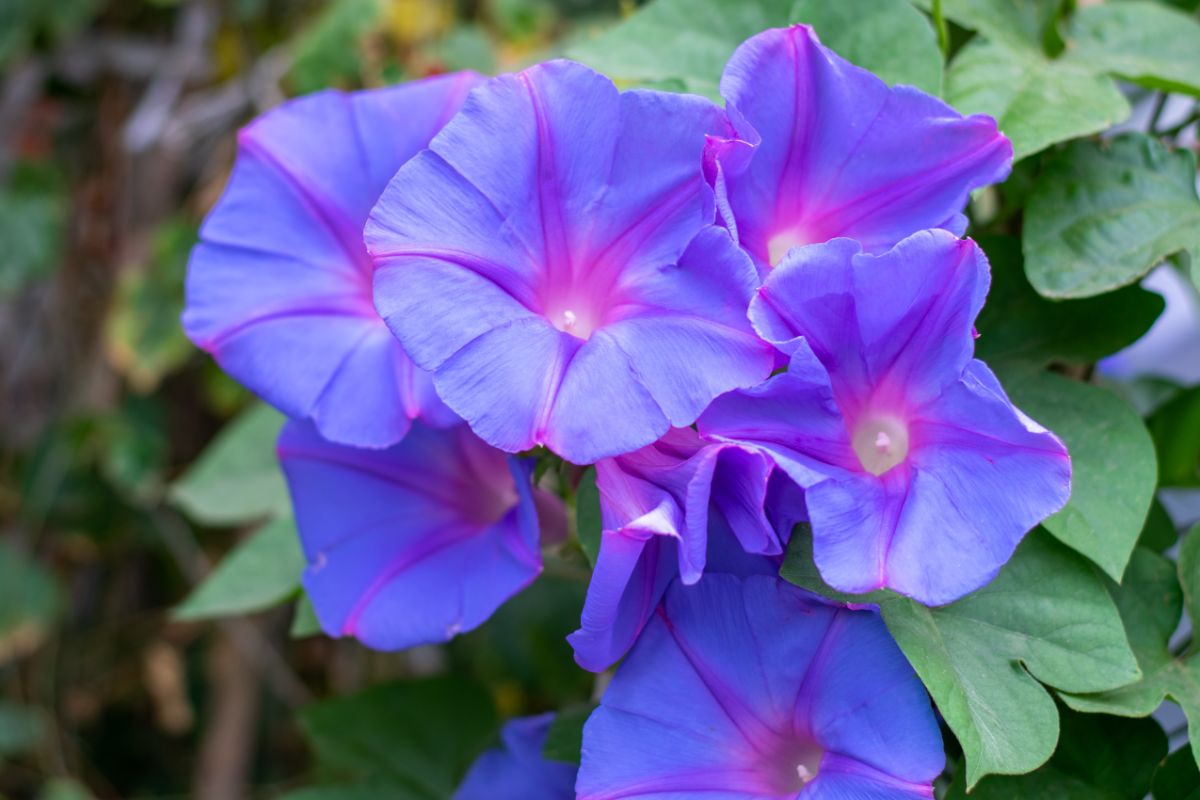
Nope, you are not imagining it—morning glory flowers really do change color. They do this in response to changes in pH, just like hydrangeas. Sometimes, those hue changes can be quite dramatic and can take place within just one day. It may amaze you to check on yours between morning and evening to see how they have changed. On just one plant, you might see a blossom change from red to pink to blue.
Are Morning Glories Invasive?
It is important to be aware that some species of morning glory are considered invasive in certain locations and may not even be legal to grow in those areas.
Almanac explains, “The attractive annual morning glory (Ipomoea spp.) is often mistaken for its perennial cousin, field bindweed (Convolvulus arvensis), which is an aggressive, invasive weed native to Europe and Asia. Field bindweed—also called “perennial morning glory” or “creeping jenny”—grows similarly to annual morning glories but sends out deep, deep roots, which make it very difficult to get rid of and allow it to overwinter in areas where cultivated morning glories could not.”
To be clear, Missouri Botanical Garden points out that Ipomoea is a tender perennial. So, it is not an “annual” in the strict sense; you can have it come back every year under the right climate conditions.
Before you purchase a morning glory, you should check with your local authorities to make sure you are not breaking any laws.
Arizona was one state that particularly cracked down on morning glories, even going so far as to extend its ban to non-invasive, endemic species.
In 2020, regulators finally reversed this decision, allowing people in Arizona to legally cultivate native morning glories.
If you are curious about Arizona’s past and present policies regarding morning glories, this is a good reference.
Morning Glory Basics
| Zones: | 9-11 |
| Blooming season: | Summer and fall |
| Expected height: | Up to 10 feet |
| Soil: | Moist yet well-draining |
| Sun: | Full sun |
Where Do Morning Glories Grow?
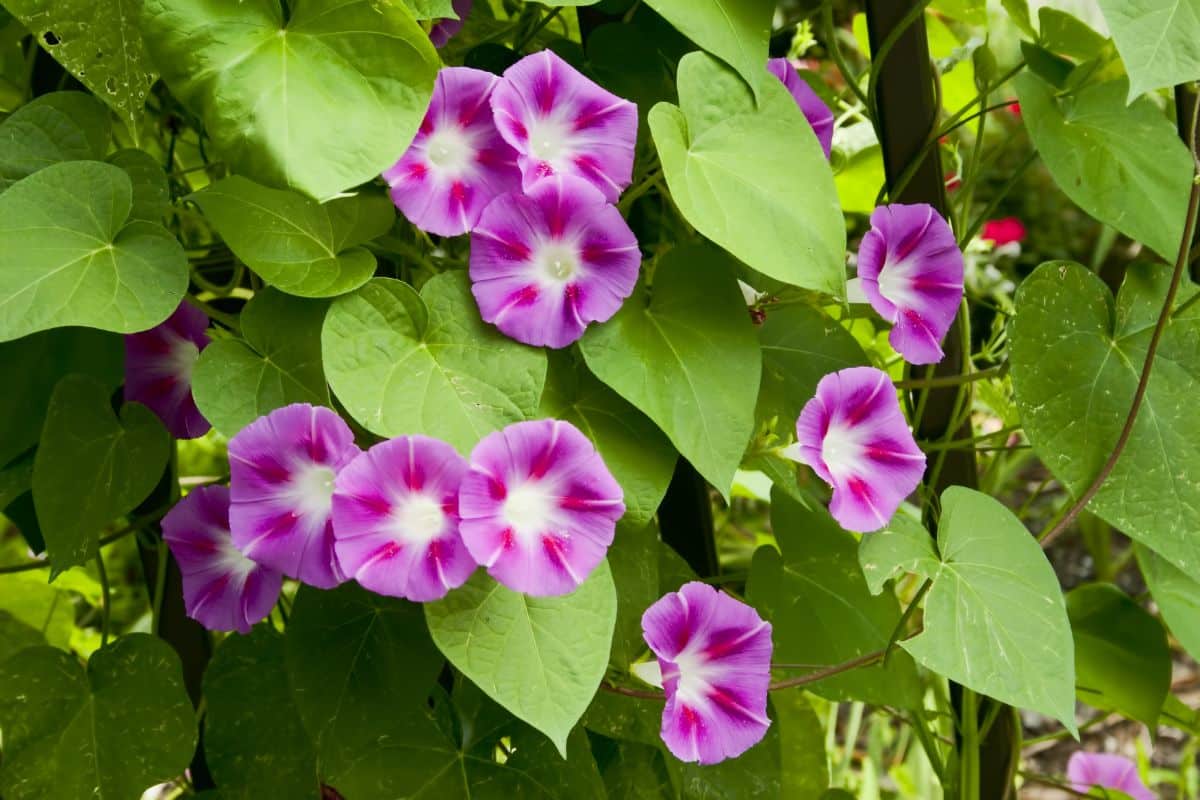
Morning glories are native to South and Central America. Since then, they have made their way to North America as well and are also cultivated elsewhere around the world.
Why Grow Morning Glories?
There are so many reasons to grow morning glories in your garden. Here are some of their main benefits:
• Long bloom time: Months of continuous spectacular blooms make morning glories a gorgeous addition to your garden that you can enjoy throughout the growing season.
• Landscaping: As you’ll discover in the next section, morning glories can be used as ground cover or borders, trained to grow up walls, and more.
• Extremely low maintenance: Morning glories are some of the easiest tender perennials to care for. You often do not need to water them, and they require little in the way of fertilizing and pruning.
• Tolerates poor soil: If you are having a hard time finding other plants to grow in your poor soil, try planting morning glories instead. They will love it.
• Wide variety: There are so many popular varieties of morning glory vines you can plant in your garden.
• Easy to plant: With a lot of perennial plants, starting from seed is a slow and arduous process that can test your patience. But this is not the case with morning glories. You will find it is fast and easy to sow directly from seed indoors or outdoors. So, you do not need to purchase nursery plants (unless you want to). Being able to plant morning glories from seed makes them cost-effective as well.
• Fun color-changing effects: How cool is it that the blooms on morning glories can dramatically shift hue throughout the course of a single day? Observing this effect can be fascinating!
Morning Glory Landscaping Ideas
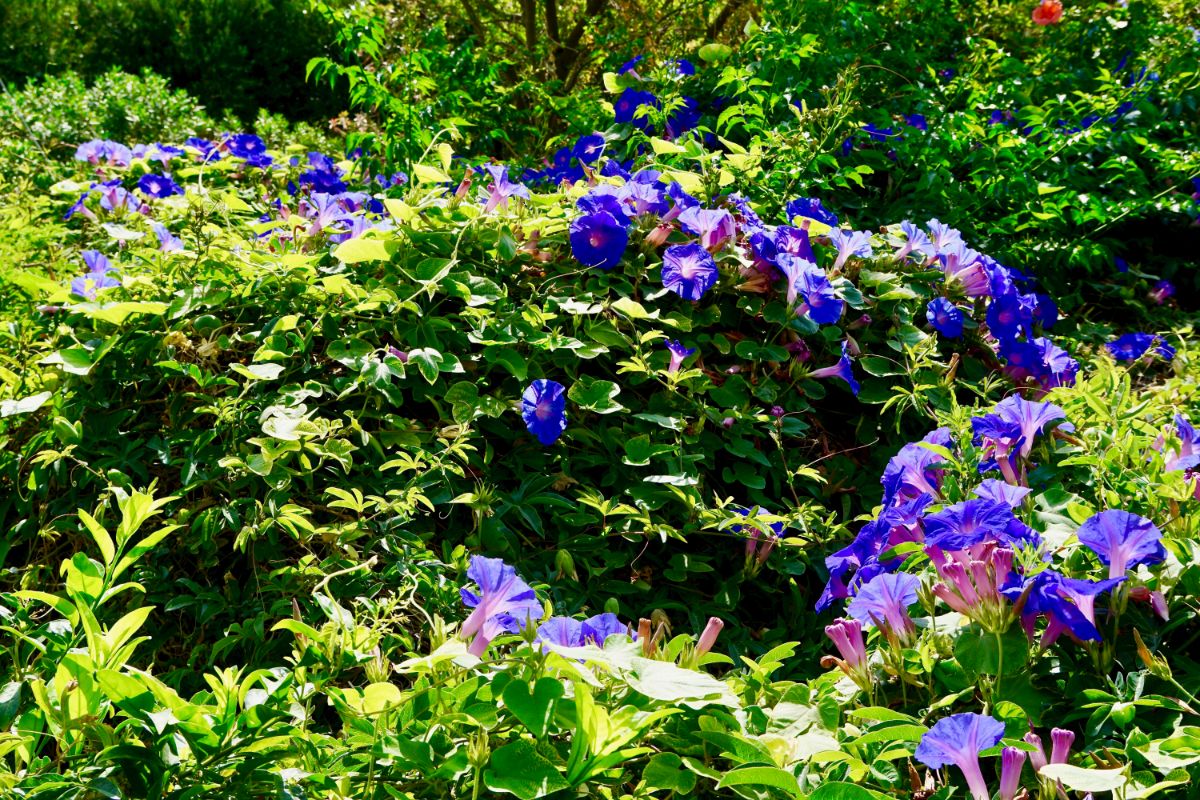
Morning glory is a versatile plant that you can use in diverse ways in your garden. Here are a few ideas:
• Groundcover: Morning glory can make a surprisingly good groundcover, filling a large section of your yard with prolific foliage and blooms.
• Line a path: You can grow morning glory as a ground cover along the side of a path, or you can grow morning glory bushes as borders.
• Surround a focal point: Bush morning glories can mound up beautifully around a tree, post, or another focal point in your landscape.
• Grow on a fence: Growing morning glories on fences is popular, especially wire fences, as they are like ready-made trellises. A morning glory vine is a vast improvement aesthetically on this type of fence as well, so it is a win-win.
• Grow on an arbor: Morning glories are the perfect vines to twine around a garden trellis.
• Grow up a wall: Gardeners can train morning glories to grow up their walls for a dramatic effect.
• Container garden: By adding trellises to containers, you can grow morning glories upward, setting them out on your porch, patio, or deck.
• Moonlight garden: Night-blooming morning glories are a splendid addition to a moonlight garden. Moonflowers, in particular, with their white petals, stand out magnificently in the dark.
Recommended Morning Glory Varieties

Let’s take a look at some morning glory varieties and cultivars that can bring beauty to your garden.
• Cardinal Climber: If you are shopping for a morning glory that is a favorite of hummingbirds, you cannot go wrong with the Cardinal Climber, also sometimes referred to as the “Hummingbird Vine.” The flowers, unsurprisingly, are a vibrant red. This type of morning glory is also considered to be deer-resistant.
• Flying Saucers: For summer- and fall-blooming blue flowers, think about planting “Flying Saucers.” The sky-blue blooms are streaked with white and have sunny centers.
• Moonflower: The classic white morning glory is the Moonflower. Just as their name implies, Moonflower vines bloom at night. You will see them rapidly unfolding in the evenings in summer and fall, producing a beautiful aroma. Their appearance is very elegant, and they are breathtaking to behold in the moonlight.
• Blue My Mind: This is a dwarf morning glory with blue blooms that is perfect for planting in your containers.
• Seta: This distinctive type of morning glory features white flowers with small, triangular pinkish-purplish marks on the petals.
• Knowlians Black: It may surprise you to learn that the range of colors of morning glories includes flowers that are a deep purplish color that is almost black.
• Common Morning Glory: This plant features flowers with white throats and purple petals.
• Split Second: One of the most intriguing types of morning glories you will find is the “Split Second.” It stands out due to the unusual appearance of its pink and white petals, which look a bit like delicate tissue paper.
• Cypress Vine: If you want a morning glory that features distinctive foliage, try planting this popular vine. The leaves have a ferny appearance, and the flowers are bright red.
• Tie-Dye: These white flowers are speckled with purple, pink, and blue.
• Carnevale di Venezia: The blooms of these morning glories are white with wide and narrow bands and streaks of blue, purple, and pink. There is also a similar-looking type of morning glory called “Harlequin.”
• Inkspots: The blooms of this type of morning glory are dark purple, pale blue, and white. On the petals are small purple markings rather like “ink spots.”
• Grandpa Ott: For purple flowers, think about planting this popular cultivar of morning glory. They attract hummingbirds and other pollinators.
• Cypress Vine – Rose: Like the Cypress Vine, but looking for different flower color? Try this version, which has the same fern-like foliage, but pink blooms instead of red ones.
• Morning Call Chocolate: The blooms of this cultivar of morning glory are a beautiful muted brownish-pinkish hue.
When Do Morning Glories Bloom?

The morning glory bloom period begins in summer and continues all the way into autumn. They will stop blossoming when the first frost arrives.
How Long Do Morning Glories Bloom?
Each individual bloom on a morning glory vine only graces your garden for a day. But do not fret because morning glories produce new blooms continuously. So, even as old blooms are fading, new ones are opening day after day.
When to Plant Morning Glories
The time to plant morning glories is in spring. Wait until the last spring frost is over before you plant them directly outdoors. Otherwise, you can start them indoors sooner if you prefer.
Ideal Growing Conditions for Morning Glories
Let’s go over the sun, soil, and water requirements for morning glories so you can get these vines to grow vigorously and produce abundant blooms.
How Much Sun Do Morning Glories Need?
Put your morning glory where it will get plenty of sunlight. Morning glories grow best when they have full sun, but partial shade may be okay if the shade is quite limited.
What Type of Soil is Right for Morning Glories?
Like many other plants, morning glories grow best in moist, well-drained soil. They also prefer poor soil to rich soil and bloom more profusely when the soil is on the lean side. As far as pH goes, neutral soil is preferable, but they can still grow in alkaline or acidic soil.
How Much Water Do Morning Glories Need?
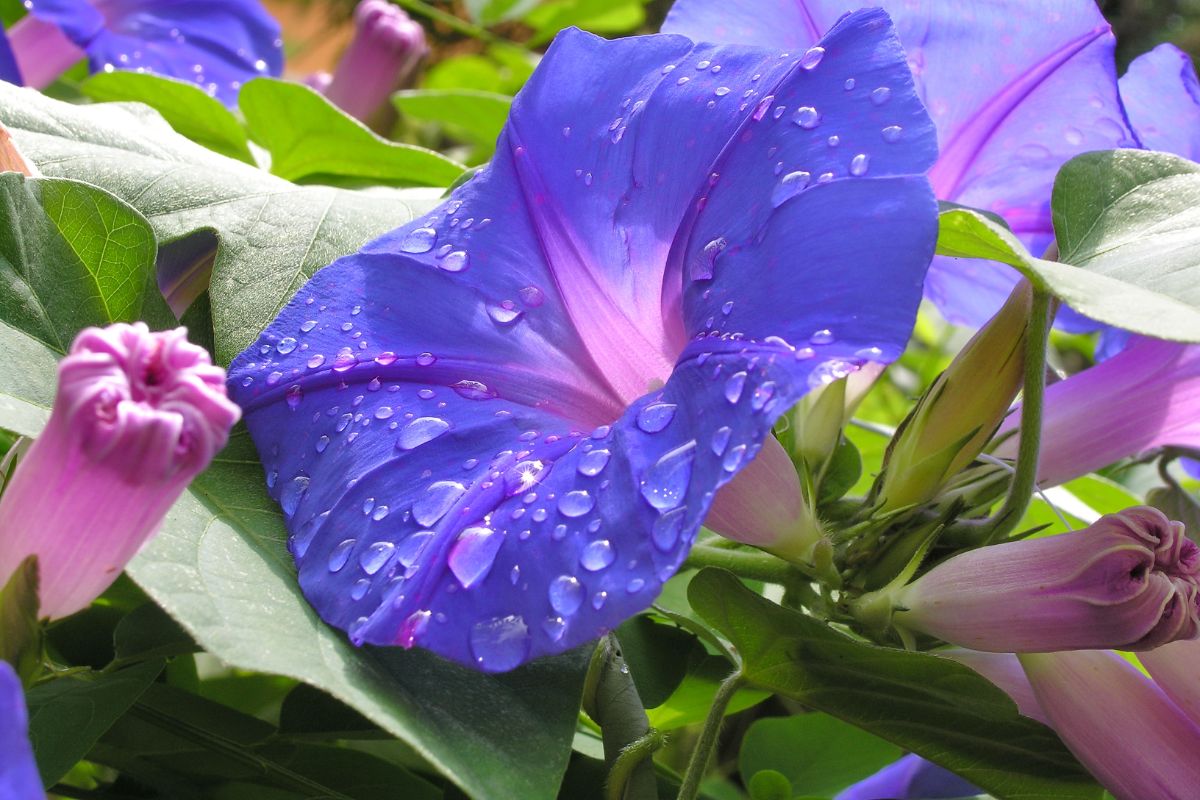
Once your morning glory vines are established, they need about an inch of water weekly. If they get sufficient rainfall, you can leave them alone. But they will need regular watering during dry spells.
How to Plant Morning Glories
You can find starter plants for sale from nurseries, but most gardeners plant morning glories from seeds since it is so easy. So, for the instructions below, we will assume you are starting with seeds.
Ground Planting
1. Scarify the seeds.
2. Soak the seeds for 24 hours.
3. You shouldn’t need to do much to prepare the soil for planting. Ideally, the pH should be neutral, but acidic and alkaline conditions generally do not cause problems for morning glories.
So, if you want, you can take the extra step of raising the pH or lowering it to make it more neutral. But it is also fine to skip it.
4. Sow the morning glory seeds. They should each be spaced apart around 6 inches.
5. Add a quarter inch of soil on top of the seeds.
6. Carefully water the seeds, making sure you do not dislodge them.
7. Wait for the seeds to germinate. It can take anywhere from 1-3 weeks.
Container Planting
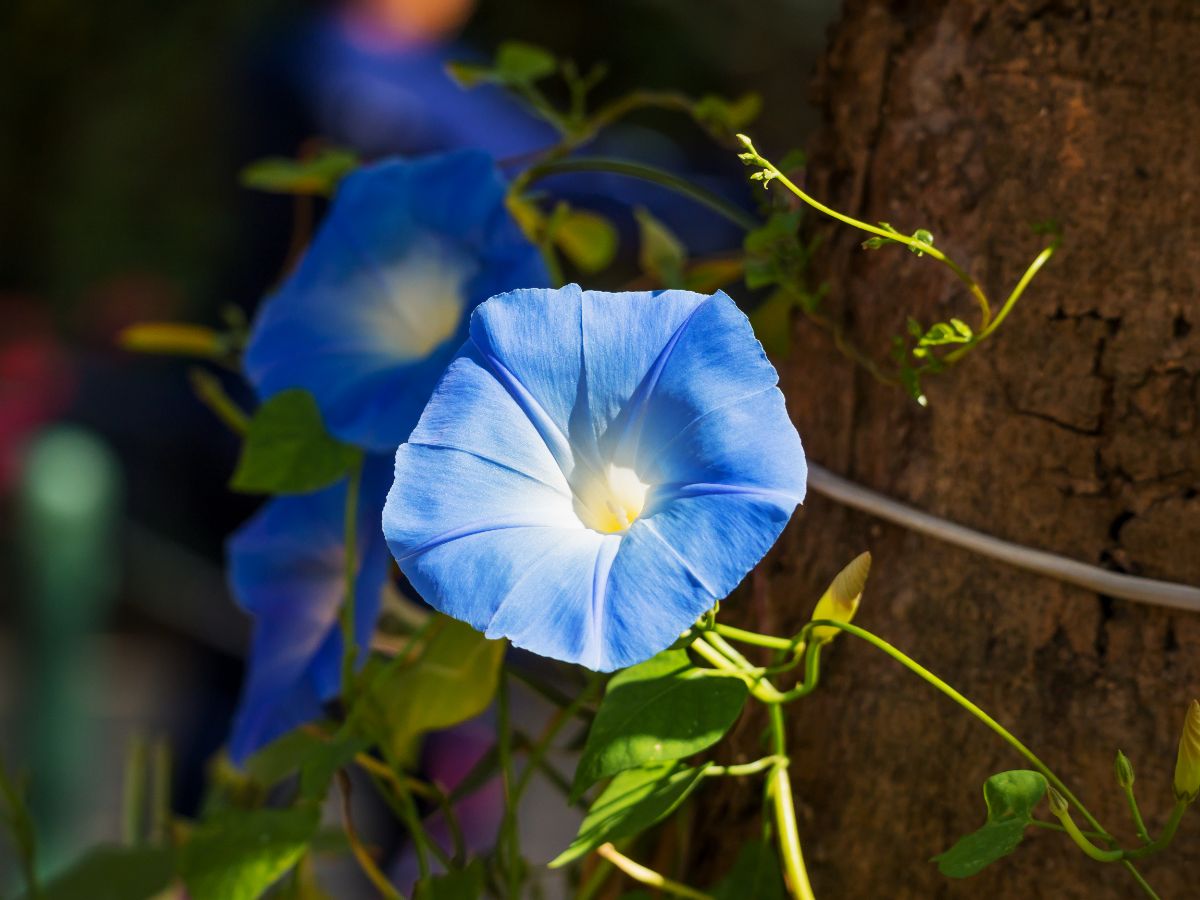
1. Choose a container that has a diameter of around 8-10” and has drainage holes.
2. Fill the container with well-draining potting soil.
3. About 4-6 weeks before you expect the final frost of the year, scarify the seeds and soak them for 24 hours.
This is only if you want to start the seeds indoors. If you would rather start the seeds outdoors, you should wait until the soil temperature outside reaches 60 degrees Fahrenheit. Then, scarify and soak the seeds as indicated.
4. After your seeds are done soaking for a full day, sow them and cover them with a quarter inch of soil.
5. Water the soil carefully.
6. Wait 1-3 weeks for the seedlings to sprout. Once they do, thin them out. Leave just 2-3 seedlings in each of your containers.
How to Propagate Morning Glories
We do not see any indication that gardeners divide morning glory plants. This may be because they are so often grown as annuals. But it could also be that a well-established perennial vine can be hard to divide.
Thankfully, there are three other ways you can propagate morning glories. The first, of course, is simply to collect seeds. The others are to take cuttings or try layering.
Starting Morning Glories from Cuttings
1. Take cuttings that are 4-6” from your morning glories.
2. Place the cuttings in the water and wait for them to form roots. Refresh the water as needed to prevent rot.
3. Once the cuttings are sufficiently well-rooted, you can transplant them into the soil.
It is smart not to wait too long before you take the cuttings out of the water and put them in the soil.
Also, even though morning glories love full sun, you might want to think about keeping the new morning glory from the cutting in partial shade, to begin with, just so it has a chance to adapt before being moved to full sun.
Starting Morning Glories by Layering

1. Choose a stem on an existing morning glory in your yard and nick it.
2. Bend it downward and cover the nicked portion with a little soil. You may need to set a rock or something heavy down on top of it. Otherwise, it will just spring free of the soil.
3. The wounded portion you buried will sprout roots.
4. Once the roots are well-developed, you can remove the soil and pull up the stem. Detach the rooted portion from the parent plant. You now have a new morning glory plant.
5. Transplant the new plant into the ground or a container.
How to Care for Morning Glories
Now that you know how to plant and propagate morning glories, let’s go over how you can maintain these tender perennials so that they are happy in your garden.
How to Fertilize Morning Glories
After you plant morning glory, consider adding liquid fertilizer with a balanced formula. Do not overdo it.
Some gardeners choose to continue to fertilize their morning glory plants once a month throughout the season.
What happens if you over-fertilize morning glory? It will still grow, but it will produce fewer flowers than you might like and a lot more leaves. This can also happen if you use a high-nitrogen fertilizer.
How to Mulch Morning Glories
To retain moisture in the soil and keep weeds from growing too close to your morning glories, add a layer of mulch. Do not put the mulch too close to the stems of your morning glories. You do not want to promote stem rot.
How to Stake Morning Glories
Whether or not you need to support and train morning glory depends on the type you are growing and how you are incorporating it into your landscape.
Morning glory can be grown as a bush or groundcover. When taking that approach, you do not need to stake or train them. They can grow unsupported.
But if you want them to climb up a fence, wall, or another surface, then you are going to need to help them along.
You should push your trellis into the ground before planting your morning glory so as not to harm the roots.
As the morning glory starts to grow, you can weave it through the trellis by hand, directing its path as you see fit.
How to Prune Morning Glories

Pruning requirements for morning glories are minimal.
How to Deadhead Morning Glories
Deadheading morning glories is optional. While pinching off the old blooms can encourage new ones, most morning glories will produce abundant blooms whether you bother with this step or not.
Another reason to consider deadheading is to stop the plant from going to seed if you do not want it to spread.
This may be important if you have one of the more aggressive types of morning glory plants.
When to Cut Back Morning Glories
Many gardeners trim back their morning glories in mid-season, removing as much as a third or a half of each plant.
The purpose of this mid-season trim is to revitalize morning glories that are beginning to look leggy and which have stopped producing the prolific blooms you expect.
As the plant grows back after its trim, it should start blossoming more abundantly again and maintain a tidier appearance.
In winter, you can trim your morning glory back again in preparation for the next growing season. Just leave about six inches.
Are Morning Glories Vulnerable to Diseases or Pests?

Some diseases that may affect morning glories include black rot, damping off, rust, and stem cankers. Diseases may result from plants receiving too much or too little water, the wrong amount of sunlight, or insufficient airflow.
Pests can sometimes damage morning glory as well. These include leaf miners, Japanese beetles, spider mites, leafcutters, and cotton aphids. Slugs and snails can also be quite problematic for morning glory vines.
Deer and rabbits may try to eat morning glories, despite the fact that they are toxic to rabbits.
Recommended Planting Combinations for Morning Glory
What should you plant with morning glories? Let’s take a look at a few ideas for morning glory companion plants.
• Some people say that pole beans and morning glories make particularly good companions. They both are vigorous growers, and their foliage and flowers together can look dense and beautiful.
• Evergreens. Gardeners sometimes recommend junipers or other evergreen plants to accompany morning glories.
While certain plants can flourish next to morning glories, be aware that these vines can easily stifle a lot of other plants. So, make sure you do not grow morning glory too close to anything it might overwhelm. Morning glory companion plants need to be able to hold their own.
Frequently Asked Questions About Morning Glories
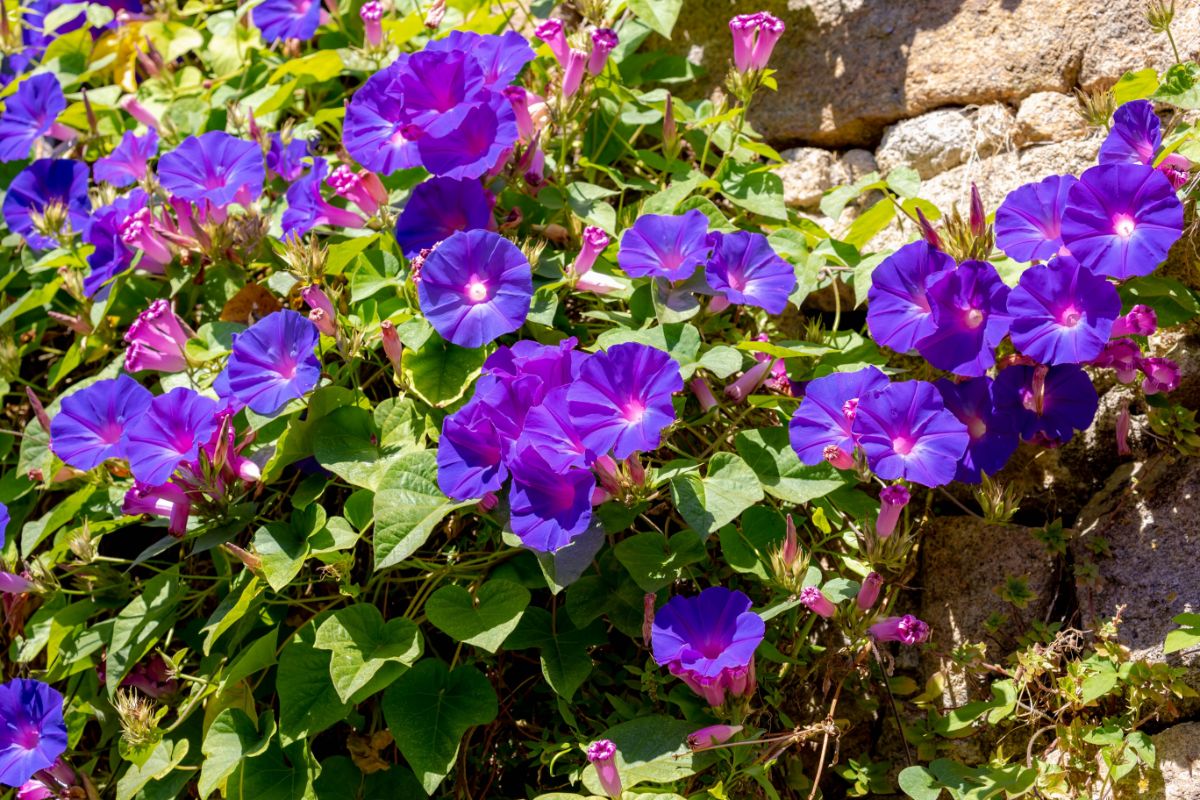
To wrap up our guide, here are answers to some frequently asked questions about morning glories.
Insects, slugs, and snails are most likely to be eating your morning glories, but mammals might also be consuming them.
Some parts of the morning glory plant are edible by humans, while others are not.
You should not eat the seeds of the morning glory plant. They are toxic and also contain a compound called LSA, which is similar to LSD. So, they can get you high.
Moreover, they can get you sick. Inverse explains, “Unlike its more refined cousin, LSA can trigger a high degree of discomfort in the user. That discomfort can come in the form of cramping, extreme nausea, other stomach pains, and even vomiting. It’s an unpleasant slew of experiences to be confronted with when all you’re looking for is a good trip.”
So, even if you are curious about the psychedelic effects of morning glory seeds, you might be better off not experimenting with them.
You can, however, eat the flowers of morning glories.
There is also a type of morning glory plant called Ipomoea aquatica, which is colloquially referred to as “water spinach.” In Southeast Asian cuisine, the shoots are a popular ingredient to use in stir-fried dishes and salads.
Interestingly enough, sweet potatoes are part of the morning glory family as well and may sometimes be called “tuberous morning glory.”
Some people report experiencing an allergic reaction to morning glory, resulting in a rash if they touch the plant. If you are getting rashes after handling morning glory, try wearing gloves going forward.
Yes, morning glories are toxic to cats and dogs and also to horses. Keep your pets away from these plants.
Rabbits sometimes seem to want to eat morning glories, but we have seen these plants included on multiple lists of plants that are toxic to rabbits. So, it alarms us a bit that we also see pictures of rabbits eating morning glories.
Given that they make multiple toxic plant lists, we suggest that you never feed morning glory to your rabbits.
Morning glories are tender perennials, meaning they grow as perennials in warmer climate zones. In a colder climate zone, you can grow morning glory as an annual plant.
Where to Buy Morning Glories
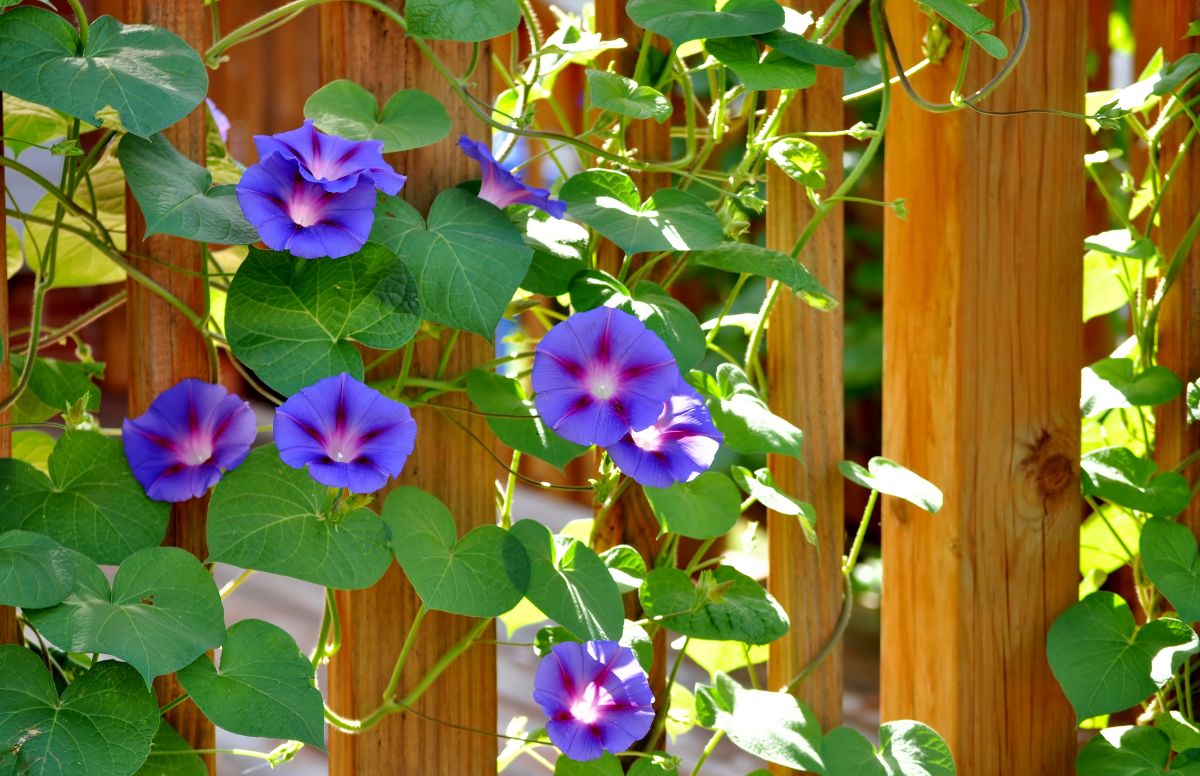
You now know how you can grow morning glories successfully. Online, you can find a great selection of these flowering tender perennial vines. Enjoy watching their petals unfold each morning and change color throughout the day.









Pam
Thanks for a comprehensive planting guide!!
Mary Ward
You're welcome!